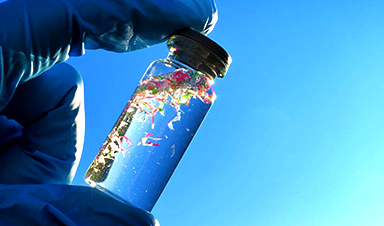Researchers found that natural polymers derived from okra and fenugreek are highly effective at removing microplastics from water.
The same sticky substances that make okra slimy and give fenugreek its gel-like texture could help clean our water in a big way. Scientists have discovered that these natural plant extracts are surprisingly good at trapping microplastics, tiny plastic particles that pollute oceans, rivers, and even our drinking water.
In fact, researchers found that extracts from okra and fenugreek can remove up to 90 percent of microplastics from ocean water, freshwater, and groundwater. These results were recently published in the journal ACS Omega.
Rajani Srinivasan and her research team have been searching for safe, plant-based ways to remove pollutants from water. In earlier lab experiments, they tested extracts from okra, fenugreek, and tamarind. They found that these natural polymers grab onto microplastics, causing them to clump together and sink to the bottom, making it much easier to separate the plastics from the water.
Srinivasan spoke about successful demonstrations of the plant extracts in freshwater and ocean water at ACS Spring 2022, a meeting of the American Chemical Society. In this next stage of the research, they have optimized the process for okra and fenugreek extracts in various types of water.
To extract the sticky plant polymers, the team soaked sliced okra pods and blended fenugreek seeds in separate containers of water overnight. Then, researchers removed the dissolved extracts from each solution and dried them into powders. Analyses showed that the powdered extracts contained polysaccharides, which are natural polymers.
Lab Tests Show High Efficiency of Natural Powders
Initial tests in pure water spiked with microplastics showed that:
- One gram of either powder in a quart (one liter) of water trapped microplastics the most effectively.
- Dried okra and fenugreek extracts removed 67% and 93%, respectively, of the plastic in an hour.
- A mixture of equal parts okra and fenugreek powder reached maximum removal efficiency (70%) within 30 minutes.
- The natural polymers performed significantly better than the synthetic, commercially available polyacrylamide polymer used in wastewater treatment.
Then the researchers tested the plant extracts on real microplastic-polluted water. They collected samples from waterbodies around Texas and brought them to the lab. The plant extract removal efficiency changed depending on the original water source: Okra worked best in ocean water (80%), fenugreek in groundwater (80-90%), and the 1:1 combination of okra and fenugreek in freshwater (77%). The researchers hypothesize that the natural polymers had different efficiencies because each water sample had different types, sizes, and shapes of microplastics.
Polyacrylamide is currently used to remove contaminants during wastewater treatment, but the researchers say that okra and fenugreek extracts could serve as biodegradable and nontoxic alternatives.
“Utilizing these plant-based extracts in water treatment will remove microplastics and other pollutants without introducing additional toxic substances to the treated water,” says Srinivasan, “thus reducing long-term health risks to the population.”
Reference: “Fenugreek and Okra Polymers as Treatment Agents for the Removal of Microplastics from Water Sources” by Rajani Srinivasan, Rajita Bhuju, Victoria Chraibi, Mihaela C. Stefan, Nguyen Hien, Damla Ustundag, Jeri La Neice Gill, Nikolas Rasmussen, Blake Saurenmann, Joe Bracerra, Michael Fowler, Hailey White and Marconi Azadah, 10 April 2025, ACS Omega.
DOI: 10.1021/acsomega.4c07476
The authors acknowledge funding from the U.S. Department of Energy; Tarleton State University; High Plains Water District located in Lubbock, Texas; the Burnaby Munson Endowed Research Professorship; the National Science Foundation Research Experiences for Undergraduates program; and the Welch Foundation.
News
Very low LDL-cholesterol correlates to fewer heart problems after stroke
Brigham and Women's Hospital's TIMI Study Group reports that in patients with prior ischemic stroke, very low achieved LDL-cholesterol correlated with fewer major adverse cardiovascular events and fewer recurrent strokes, without an apparent increase [...]
“Great Unified Microscope” Reveals Hidden Micro and Nano Worlds Inside Living Cells
University of Tokyo researchers have created a powerful new microscope that captures both forward- and back-scattered light at once, letting scientists see everything from large cell structures to tiny nanoscale particles in a single shot. Researchers [...]
Breakthrough Alzheimer’s Drug Has a Hidden Problem
Researchers in Japan found that although the Alzheimer’s drug lecanemab successfully removes amyloid plaques from the brain, it does not restore the brain’s waste-clearing system within the first few months of treatment. The study suggests that [...]
Concerning New Research Reveals Colon Cancer Is Skyrocketing in Adults Under 50
Colorectal cancer is striking younger adults at alarming rates, driven by lifestyle and genetic factors. Colorectal cancer (CRC) develops when abnormal cells grow uncontrollably in the colon or rectum, forming tumors that can eventually [...]
Scientists Discover a Natural, Non-Addictive Way To Block Pain That Could Replace Opioids
Scientists have discovered that the body can naturally dull pain through its own localized “benzodiazepine-like” peptides. A groundbreaking study led by a University of Leeds scientist has unveiled new insights into how the body manages pain, [...]
GLP-1 Drugs Like Ozempic Work, but New Research Reveals a Major Catch
Three new Cochrane reviews find evidence that GLP-1 drugs lead to clinically meaningful weight loss, though industry-funded studies raise concerns. Three new reviews from Cochrane have found that GLP-1 medications can lead to significant [...]
How a Palm-Sized Laser Could Change Medicine and Manufacturing
Researchers have developed an innovative and versatile system designed for a new generation of short-pulse lasers. Lasers that produce extremely short bursts of light are known for their remarkable precision, making them indispensable tools [...]
New nanoparticles stimulate the immune system to attack ovarian tumors
Cancer immunotherapy, which uses drugs that stimulate the body’s immune cells to attack tumors, is a promising approach to treating many types of cancer. However, it doesn’t work well for some tumors, including ovarian [...]
New Drug Kills Cancer 20,000x More Effectively With No Detectable Side Effects
By restructuring a common chemotherapy drug, scientists increased its potency by 20,000 times. In a significant step forward for cancer therapy, researchers at Northwestern University have redesigned the molecular structure of a well-known chemotherapy drug, greatly [...]
Lipid nanoparticles discovered that can deliver mRNA directly into heart muscle cells
Cardiovascular disease continues to be the leading cause of death worldwide. But advances in heart-failure therapeutics have stalled, largely due to the difficulty of delivering treatments at the cellular level. Now, a UC Berkeley-led [...]
The basic mechanisms of visual attention emerged over 500 million years ago, study suggests
The brain does not need its sophisticated cortex to interpret the visual world. A new study published in PLOS Biology demonstrates that a much older structure, the superior colliculus, contains the necessary circuitry to perform the [...]
AI Is Overheating. This New Technology Could Be the Fix
Engineers have developed a passive evaporative cooling membrane that dramatically improves heat removal for electronics and data centers Engineers at the University of California San Diego have created an innovative cooling system designed to greatly enhance [...]
New nanomedicine wipes out leukemia in animal study
In a promising advance for cancer treatment, Northwestern University scientists have re-engineered the molecular structure of a common chemotherapy drug, making it dramatically more soluble and effective and less toxic. In the new study, [...]
Mystery Solved: Scientists Find Cause for Unexplained, Deadly Diseases
A study reveals that a protein called RPA is essential for maintaining chromosome stability by stimulating telomerase. New findings from the University of Wisconsin-Madison suggest that problems with a key protein that helps preserve chromosome stability [...]
Nanotech Blocks Infection and Speed Up Chronic Wound Recovery
A new nanotech-based formulation using quercetin and omega-3 fatty acids shows promise in halting bacterial biofilms and boosting skin cell repair. Scientists have developed a nanotechnology-based treatment to fight bacterial biofilms in wound infections. The [...]
Researchers propose five key questions for effective adoption of AI in clinical practice
While Artificial Intelligence (AI) can be a powerful tool that physicians can use to help diagnose their patients and has great potential to improve accuracy, efficiency and patient safety, it has its drawbacks. It [...]





















